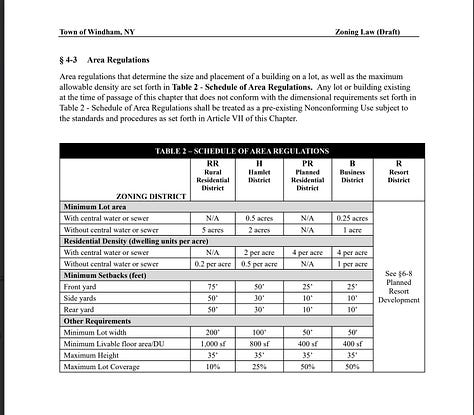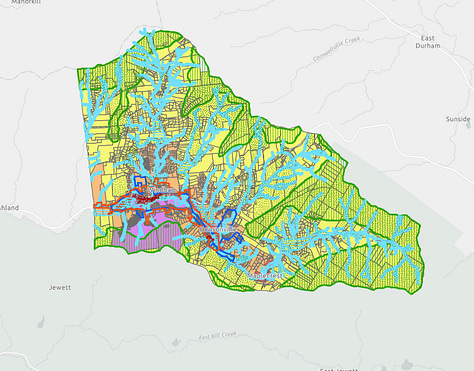Some are probably curious as to why I’m so concerned with the median age of our community trending to 65.3 years of age by 2050. Two and a half decades from now seems like a considerable amount of time. However, in reality, we cannot depend on 25 years before reaching serious age issues with the makeup of the town’s population. In fact, 25 years is an optimistic projection based on the community being able to maintain a relatively static population ranging between 1,660-1,720 residents for the next 25 years. And that our continual trend of the median age increasing stays stable at 4.2 years per decade. If any number of factors shift radically, we might see our median age accelerate its steep climb toward retirement ages long before 2050.
What Is Windham Facing?
Low birth rates: “NYS published that between 2008-2012, Greene had only 1,908 births, down from 2000-2004’s 1,939 births”.
Since New York State 2012 has been leading the country in lost population.
Greene County in 2022-2023 saw -a 0.2% loss in generation population according to Cornell University and the NYS Department of Labor.
10.5% of internal State migration nationwide was due to affordable housing in 2023.
In 2023, 16.4% of the migration in NYS was due to funding new or better housing.
Windham’s housing market has surged since 2000, with 2014 the median value of housing being $240,000, almost double that of the Greene County value of $179,700 at the time. According to Realtor.com, the median home selling price in May of 2025 was $695,000, which is more than double the Greene County housing sale price of $340,000 that New York State’s Department of Taxation and Finance reported.
Lack of Affordable Housing Stock, as early as 2014, Windham was already showing what was then termed an “incredible 60.5% vacancy rate in homes.” By the 2020 Comprehensive Plan, the figure had risen by 6.6% to 67.1% of all homes being vacant.
Lack of a broad base of employment.
These factors are all playing into what our community is facing. So, you can see why I’m concerned about the general issues in our community when it comes to population, economic growth, and affordable housing. They are all interconnected, and most importantly, when one or two of these important pillars of the economy start to weaken, a major collapse is sure to occur. In the video for the 2020 Comprehensive Plan of Windham, our town Supervisor claims no one can predict the future. What should be said is that we might not be able to predict specific events, but we certainly can predict with decent certainty what will happen if specific trends are allowed to progress to their natural conclusions.
This chart from the New State Department of Labor shows trends in migration that we in Windham must address seriously before 2050 arrives. These trends show that New York State in general is becoming less friendly to young adults and young families with children. This specific demographic group was exiting at nearly 180,000 households per year by 2021. Between 2008 through 2021 the demographic group that maintained the lowest migration patterns in the state was group of “ Households with Over 60 years Age Members ”. These households saw a reduction of just under 40,000 households per year by 2021.
If Windham wants to reverse the present trends in our population’s size and age distribution we must plan for long-term sustainable growth. To do this the local government of Windham must move forward with plans to do two things:
Create Local Full Employment with actual careers
Create a broad base of Affordable Housing in the community
To quote economist Pavlina Tcherneva “ Growth, in other words, is the byproduct of strong employment, not the other way around”. This has to be our motto in our local government if we want to see strong growth in population and long-term sustainability in our community it will be derived from a policy of creating local employment that uses more local resources.
Otherwise, we will be shackled with a declining population in size while it is rising in age. The question is will our “Zoning Law” as drafted benefit our community? Areas of Concern:



Clearly, the new zoning law intends to ensure that large-scale construction is the primary asset in our community. For example, in the area regulations, we find some very troubling issues:
Rural Residential Homes must be at least 1,000 sq ft minimum.
Planned Residential and Business Districts are limiting the potential growth of the community by decreasing the density of dwelling units per acre.
The Off-Street parking requirements put pressure on the land owners and not the town to create better off-street parking options.
First off let’s look at the issue with Rural Residential districts (the majority of the map by the way)— if we do some quick math we find that 1,000 sq ft of stick-built housing is running $278.00 per square foot according to my recent survey. That means the house is $278,000. The Land prices in Windham are fluctuating between $45,000 per acre to $145,000 (or more) per acre. So, that makes a five plot at $45,000 per acre $225,000.00. That makes your initial investment in a house $503,000 not including permits, landscaping, architectural design, and other features. And we’re only talking about a 1,000sq ft home. Now you can see why a 2,500sq ft A-Frame on Old Road was recently advertised for $1.459 million asking price. This is no way to create affordable housing in our community.
The next issue I have is with the Planned Residential and Business Districts being limited to 4 dwelling units per acre with public sewer and water. First off if you want to create a vibrant Main Street high density is the critical factor to do this. So, if want to get 100 new families into the Main Street area that means we need 25 acres of land for the housing. That 25 acres doesn’t include 200 cars they also recommend. There just isn’t enough space on our Main Street to grow in this manner.
We should be asking the important question why are we avoiding the most important feature of smart-growth rural planning that sees the creation of walkable streets with high-density mixed-use buildings as a positive growth policy? We should be asking why aren’t trying to create a community where you can walk to work, walk to your local corner store, and then back to your home. We need a Main Street that is alive with people from 8 am to 6 pm full of employment and living opportunities. So that means we need to rethink reductions in dwelling units as a negative pressure on our future growth potential.
I would prefer to see a few buildings (2-5 at most) on our main Street in the 45 to 55 ft in height potential that use up 90% of their lots and create 2-3 floors of living space with 2-3 bedroom apartments and multiple stores underneath them. If we can build 4 buildings with 16 apartments that house families then we are moving on the right track because that would be an increase of 256 people if each of the 64 families had two children and two parents. 128 adults working in our community would be no small growth pattern in our community.
Density especially in Business District is a must to create a viable mixed-use community.
Finally, we have the parking issues. We need to focus on parking in specialized close-off-the-street public parking areas. But, we also want to promote the use of mass transit and alternative transit systems in our business districts. By creating living, working, and commerce spaces in such proximity we can create a truly walkable community. Research has shown that such communities are extremely prosperous and Windham can exploit these benefits too. So, our goal should be to create reasons why families might reduce their investments in cars and increase their investments in other modes of transportation in our community’s core.
I’m not saying we ban the car— let’s just make it less useful to the members of our community who choose to live in the core of the community. I have experience with altering my mode of transportation in an inner city and I can tell you this if we can create enough jobs on our Main Street to support 128 adults— cars will not be the primary mode of transportation if the distances to work are less than 1,500 feet.
Windham 2050— in my vision people of any age are walking and enjoying a vibrant and lively Main Street all year round. Enjoying our street fairs and farmers’ markets every spring into fall. And have at their fingertips the ability to shop at the local stores and know their neighbors while having the choice to live in a community that is welcoming and growing. It’s one where the birthrate is up because residents have stable jobs that are true careers, the ability to find affordable housing, and finally, they have affordable childcare. They know they can live in Windham and watch their children grow up and they too can choose to live in the town or move away—but it is a choice they make based on their desires, not because of a lack of opportunities in our community.







